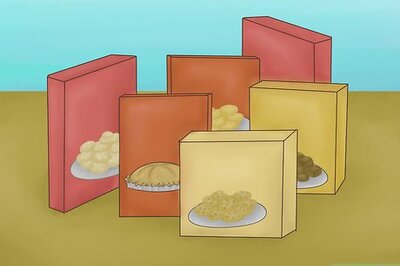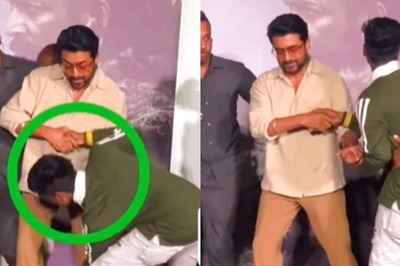
views
We are aware of the advantages of exercise. Cardio increases heart health and burns fat. Strength exercise strengthens bones, increases metabolism, reduces injuries, and builds muscle. To lead active, healthy lives, we require these advantages. But does putting in the effort require enduring painful muscles?
The good news is that there are strategies to decrease the amount of the pain you experience. Unfortunately, muscular soreness cannot be prevented if your goal is to test your muscles, which it should be regardless of your age or gender.
What results in painful muscles after exercise?
Anyone can suffer muscular soreness, whether they are new to exercise or have been exercising frequently but have lately changed the type, intensity, or duration of their program. We all create muscle the same way, which is by first breaking it down.
Your working muscles experience minute microtears due to the additional strain exerted on your body during activity. This microtearing is typical. In actuality, they are essential for muscular development. But it is also these microtears that cause discomfort. Muscle grows back stronger and healthier than before when the body recovers and repairs these microscopic injuries, but at a painful price. The sore muscles you experience after working out are a side effect of the muscles mending process, and because they don’t appear right away, they are referred to as delayed onset muscle soreness, or DOMS. The acute soreness that might occur during or immediately after completing an exercise is related to muscular fatigue, not muscle repair and strengthening, and should not be mistaken with delayed onset muscle soreness.
How soon does delayed onset muscle soreness begin to manifest and how long may it last?
Delayed onset muscular soreness often starts 12 to 24 hours after exercise and can peak anywhere between one and three days later. There is yet no conclusive explanation for why muscular soreness develops later than expected. Murray does, however, remind out that how strenuous your workout was will likely have a significant impact on how long you feel sore. The length of time it may take for muscles to repair and regenerate depends on how strenuous the activity was.
How can painful muscles be relieved after exercise?
Soreness is unavoidable if the objective is to acquire strength and muscle. But do you need to do anything to make it stop? Or do painful muscles truly merely involve dealing with the discomfort? There is no risk in waiting it out because delayed onset muscle pain is a fully natural process that shows your muscles are getting stronger. But it could feel awkward at first. Thankfully, there are several things you can do to lessen the suffering.
TOP SHOWSHA VIDEOS
Following are seven suggestions for easing tight muscles:
- Be active: Unbelievably, moving your muscles is one of the finest strategies to lessen their discomfort. Stretching, foam rolling, and yoga are all forms of active recuperation that you can do for this.
- Warm up properly: Making ensuring your muscles are prepared for use before you challenge them is a crucial component of safeguarding them. Before every workout, set aside time for a thorough warm-up.
- Enter a new fitness regimen gradually: Your muscles won’t benefit from going from 0 to 60. Providing them with some time to adjust may assist lessen the intensity of your pain. Just remember to increase the intensity of your workouts gradually over the course of a few days or weeks when beginning a new routine.
- Take a salt bath and soak: Your muscles can relax and your discomfort can be reduced by taking a warm bath with Epsom salts.
- Use an analgesic: Although it won’t hasten the process of muscle mending, this will at least make it easier for you to tolerate the related discomfort.
- Set aside time for rest: Your muscles will become overused if you don’t give them enough time to rest (and repair), which will result in more extreme soreness. Make sure to incorporate rest days where you concentrate on active recuperation. In general, remember that genuine rest (also known as sleep) and hydration are crucial for recuperation.
- Use a split-day schedule: If you enjoy working out each day, you might want to divide your workouts into different muscle groups. Legs might be the topic one day and arms the next. By doing this, you can make sure that you’re giving each muscle group enough downtime before you work it again.
How much pain is too much?
Sore can feel really painful at times. like, too painful to workout painful. You don’t need to abandon your workout just because you’re sore because, as was previously discussed, moving is a terrific approach to assist heal aching muscles. Actually, light activity will assist you increase blood flow and lessen your symptoms. Muscle discomfort typically reaches its climax around day three and then begins to subside. If your stiffness lasts more than three days, you probably overdid yourself and overworked your muscles. However, persistent muscular ache may also be a symptom of an injury.
It may be more than just muscular soreness if it lasts more than three days, is accompanied by intense pain, restricts your range of motion, or alters your stride. A sports medicine doctor should be seen if this is the case. Exercise should only be performed with caution if your discomfort is more consistent with a major injury than it is with exercise-induced soreness. If that’s the case, you should also consult a doctor about your pain.
Read all the Latest Lifestyle News and Breaking News here



















Comments
0 comment